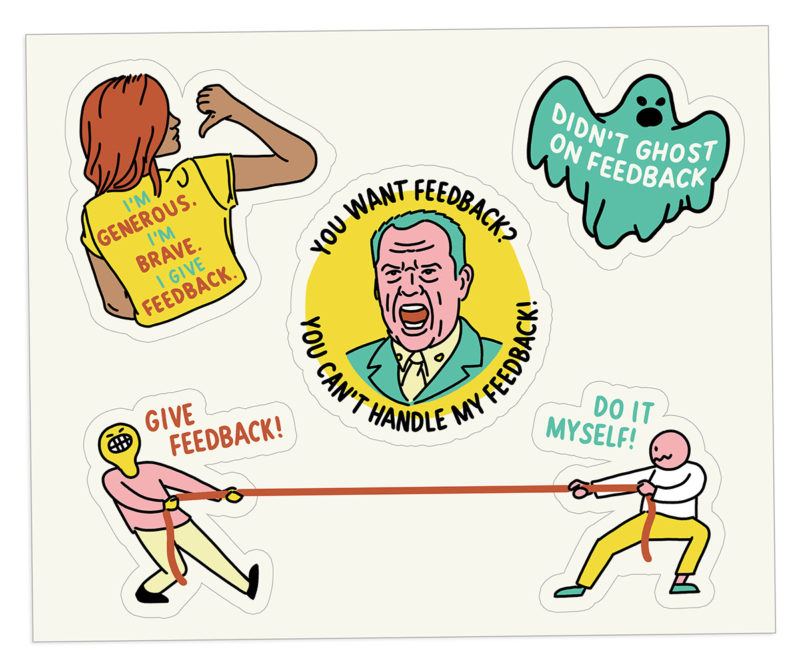How do I give feedback to someone on my team instead of just doing it myself because I can do it faster and better?
Andy: Let me say first, I think it’s absolutely okay to keep work moving along by doing it yourself. If you make every piece of work a development opportunity, you’ll go crazy. It’s too much!
Emma: Plus, if I’m doing something myself, it’s probably because it’s so far from what it needs to be, I don’t even know where to begin with feedback.
Andy: Totally. If it were simple feedback, I’d have already given it! I’m not a monster.
Emma: But I’ve always appreciated when someone dramatically changes my work that they tell me three things:
1. They are going to do it, or already did
2. They take some accountability for why what I did needs to be redone: “I realize I had something very specific in mind that I didn’t communicate to you at all” or “I reworked it based on input from the sales team — nothing you would have been able to predict.“
3. They make concrete plans to teach me if it’s something that I should know or that I want to know how to do: “I’ll walk you through the feedback and my revision in our next 1-on-1.“
Andy: If you say nothing, it’s like ghosting. You could have all the real, excellent excuses in the world — I lost your number! There was no time!— but it doesn’t matter. You’re still kind of an asshole.
Emma: Mostly because you’ve put the person being ghosted in a crappy position. What should I do: pretend the bad work never happened? Confront you, my boss, to ask for the feedback you chose not to provide? Neither one feels great. It’s next-step no man’s land.
Andy: And having your work redone in silence is the perfect invitation for negative swirling: What was wrong with it? What is wrong with me? Will I do the next one wrong in the same way? Am I about to be fired? They should fire me. I’d fire me.
Emma: Right. We don’t automatically hit Bad Boss territory by redoing someone’s work, but we start entering it when we redo someone’s work and then never talk about it. We cannonball in when it’s our go-to solution every time.
So it’s nice that giving feedback and re-doing work isn’t an either/or situation. The opportunity for feedback doesn’t end when you get your manager hands on it.
Andy: It also doesn’t end when you send it out the door. Feedback isn’t tied to a due date. And the window to provide good feedback is pretty wide — you have to wait a really long time to miss it completely.

Where to Start With Feedback When the Whole Thing Is a Disaster
You’ve got to figure out how to break gnarly projects down into feedback-size bites. One thing that’s helped us is divvying up problems into categories.
Stage 1: Things that are plain wrong
- Factual inaccuracies
- Miscalculations
- Misrepresentations
Stage 2: Core problems
- Structure
- Process
- Approach
- Philosophy
Stage 3: Cosmetic issues
- Presentation
- Execution
- Style
This is a hierarchy. Don’t worry about bedside manner when the diagnosis is wrong. Start at the top. If there’s something fundamentally incorrect, work on that. When that improves, you can celebrate the growth and graduate to Stage 2 in a future feedback session.
If all you are redoing is in Stage 3, gut-check if these cosmetic issues are matters of personal taste. Maybe it’s not how you would introduce yourself to the patient, but if it passes your scorecard for bedside manner, then it’s your problem, not the work’s. (Or, your scorecard needs to be updated.)
8 On-the-Fly Feedback Strategies
Giving feedback doesn’t have to be an arduous to-do with tons of prep work — although that doesn’t mean it requires any less generosity and bravery. Here are some quick coaching ideas we use:
• Before you start redoing the work, call the person over to do a shadow of your approach
• Share the before and after of one thing you changed and why
• Employ a “More of This, Less of That” strategy by finding one spot where a certain skill is strong, and another where it’s weak
• Send over a helpful article with a few sentences about how it applies
• Show a good example of the work from the outside world and discuss what can and can’t be applied to your project
• Have them come sit in with you when you’re getting critiqued on a similar skill
• Ask to shadow the person when they’re doing the skill next
• Pair up the person struggling with a concept with someone who is great — now your high-performer can get some experience coaching, too!

Emma: In the long run, setting up a system of routine, ongoing feedback is going to be a huge relief for you. When it’s built into the structure of your weeks, then you never have to find time where there is none.
Andy: There’s never time!
Emma: Maybe you review work for 15 minutes at the beginning of every weekly 1-on-1.
Andy: At Reviews.com, we held bi-weekly calibrations focused on areas of improvement the whole team could benefit from.
Emma: Back when Vox Storytelling Studio was a thing, I was so inspired reading about the team holding regular critiques of their work, as well as work from other publications.
Andy: If you have an ongoing feedback loop, redoing someone’s work and sending it along is way less problematic. The person already knows where they stand. They know what they need to work on. And they can trust you to help them get there.
Good Boss Achievement Stickers: Feedback Edition (Part 2)


